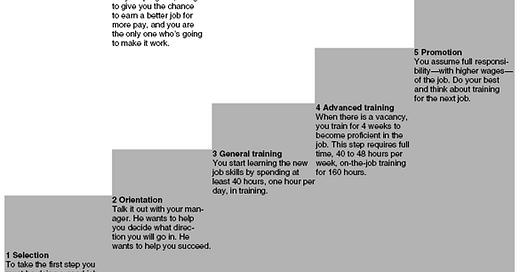About how long do you think the career ladder concept has been around?
If you want to peek ahead and see if you got it right, scroll to the end of today’s post.
This idea of climbing the corporate ladder started in a vastly different professional world than today. And while I do believe there’s a place for career ladders, there are enormous drawbacks to using it as the only reference point for success.
Author and podcaster Natalie Lue pointed this out on an episode of Ctrl Alt Delete.
“I found that I was pushing me for the sake of pushing me,” she said. “And that’s where you start to suck the joy out of things.”
“Oh my god, that — that speaks to me,” host Emma Gannon responds with a small laugh.
Viewing our entire professional life as a relentless climb puts us under enormous pressure with every decision. When I guide people on how to map their careers as a river instead, they almost always say they feel like a burden has been lifted and it opens them up to new choices.
Where a career ladder makes sense is much more limited in scope. Within a particular company, using a ladder framework to identify professional development opportunities for employees can be useful.
In fact, the oldest reference to the career ladder I found in the Harvard Business Review archives outlines exactly this approach. It’s from a 1975 article on how Marriott was working to retain talented managers despite the challenges of working in the service industry. (If you guessed the first ladder reference is about 50 years old, sorry to say this is not the answer. The career ladder concept predates even an article that refers to bellmen and “bell-ladies,” named “doorbelles,” and a booklet on how to talk to guests titled “The Switchboard Operator.”)
The article outlines a career progression program for hourly employees offering a “ladder of advancement up through positions of increasing skill, responsibility, and pay.”
Certainly leaders and managers should systematically support employees’ growth within companies. But the problem is, somewhere along the line, this idea came to encompass the entirety of our professional lives. The truth is, the modern world is far too dynamic to expect that we will steadily progress in one domain for 40-plus years. Frankly, I’d much rather pursue learning and welcome changes than battle ever upward.
So just how long has the career ladder been with us? If you chose 200 years, you’re right. Merriam-Webster pegs the first known use of career ladder in the sense we use it today to 1835, just under the two century mark.
This concept is older than the automobile and the telephone. It was being used more than a century before the 40-hour workweek became law.
I’d say it’s high time we update our expectations for a rewarding professional journey.
Happy navigating,
Bridget
Note: I’ll be taking a break for the holiday next week, and be back in your inbox in December!
Recommended 📖 read and 🎧 listen: Check out this fascinating article and Radiolab episode about the recent scientific discovery of a new body part. Journalist, Hearken CEO and my co-conspirator and former boss Jennifer Brandel describes the “interstitium,” which connects everything within the body, and explores what this vision of interconnectedness means for our work and our society.
This line in particular should resonate with career river advocates:
We ask children, “what do you want to be when you grow up?”, not “how do you want to be when you grow up?” We divide knowledge into subjects, disciplines, majors, then sectors and industries and specific job titles.
We need more navigators skipping between these constructed categories to subvert and replace a perspective of separation that has reached its limits and logical conclusion.



